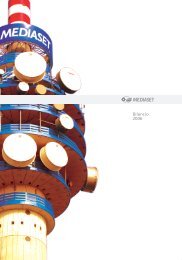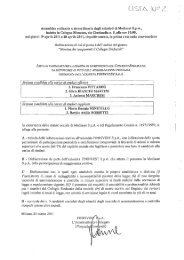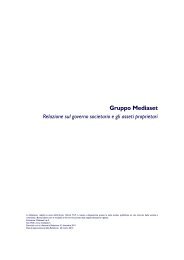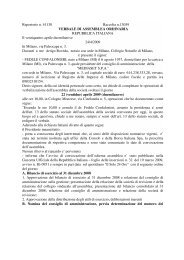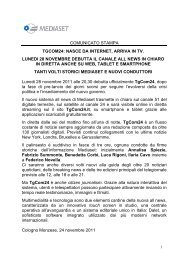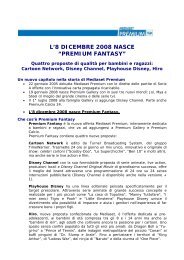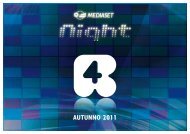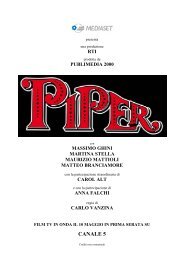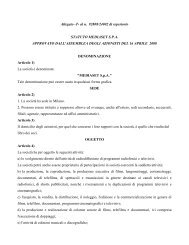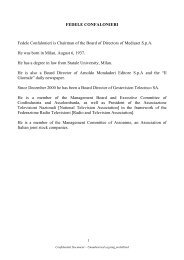ANNUAL REPORT
ANNUAL REPORT
ANNUAL REPORT
Create successful ePaper yourself
Turn your PDF publications into a flip-book with our unique Google optimized e-Paper software.
2008 Group’s Consolidated Annual Report – Explanatory Notes<br />
in compliance with IAS 39, are valued at fair value with recognition of value differences to<br />
income statement, while payables for the acquisition of rights – considered monetary items –<br />
are adjusted to the exchange rate at period end, in compliance with IAS 21.<br />
Derivative instruments include current financial assets and liabilities entered at fair value.<br />
The fair value of forward contracts on currencies is determined as the discounted difference<br />
between the notional amount valued at the contract forward rate and the notional amount<br />
valued at the fair forward (period end exchange rate calculated at the account date).<br />
The fair value of exchange rate options is calculated using the Black & Sholes method for plainvanilla<br />
options, while the binomial method is used for the Single Barrier Options (with barrier<br />
defined in reasonable times).<br />
With reference to hedging derivatives to hedge interest rate risk, the fair value of interest rate<br />
swaps is calculated using the current value of the expected future cash flows, while the fair<br />
value of collar derivatives is calculated using the Black & Sholes method.<br />
Accounting treatment varies according to the fact that these are designated as hedging<br />
derivatives pursuant to IAS 39.<br />
In particular, for the purpose of hedge accounting, Mediaset considers as hedging derivatives<br />
those financial instruments that hedge against currency exposures connected to commitments<br />
for future purchases of television rights denominated in foreign currency (forecast transaction)<br />
and those to hedge the exchange rate risk for which both the relationship between the<br />
derivative instrument and the hedged item and the likelihood/effectiveness of occurrence of the<br />
forecast transaction are formally documented.<br />
The effective component of the adjustment to fair value of the derivative instrument used and<br />
qualified as hedging derivative is directly recognised to Shareholders’ equity, while the<br />
ineffective component is entered in income statement.<br />
These operations are accounted for through cash flow hedge. According to this rule, the effective<br />
component generating changes in the value of the derivative is entered in a reserve to<br />
Shareholders’ equity. In the event of hedging commitments for the purchase of rights, such<br />
reserve is used to subsequently adjust the recognised value of the asset in the financial statements<br />
(basis adjustment) and in the event of exchange rate risk hedge, such reserve generates a<br />
proportional effect in the income statement at the same time of generation of the relevant cash<br />
flows.<br />
Changes to the fair value of derivative instruments used for financial hedging purposes, that<br />
hedge the risk of changes to the fair value of items entered in the financial statements, in<br />
particular, currency receivables and payables or derivatives that do not qualify as hedging<br />
derivatives, are recognised in the income statement under item “Financial income / loss”.<br />
Revenue recognition<br />
Revenues from sales and services are entered when the relevant risks and benefits are<br />
transferred, which derive from the actual transfer of ownership or completion of the service.<br />
In particular, the Group’s main revenues from sales are entered according to the following<br />
criteria:<br />
� advertising: upon showing of the relevant insert or advertising commercial. Revenues from<br />
advertising sales in exchange of goods (and correspondingly the cost of goods) are adjusted<br />
in order to keep the estimated recoverable value of goods into account;<br />
� goods: upon shipment or delivery. In case of lease o sub-licencing of the use of rights also for<br />
a limited period of time, implying the transfer onto the transferee of the asset’s control, the<br />
relevant revenue is fully recognised when the use of the asset is transferred;<br />
102



